Coleson Bruce’s crevice garden in spring flower
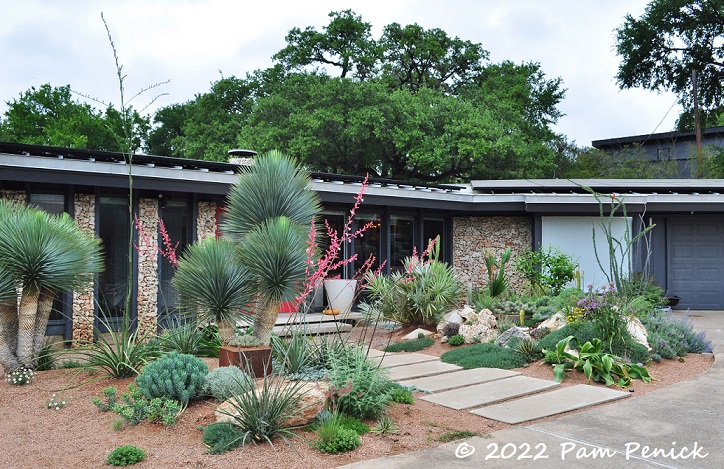
Two weeks ago Coleson Bruce invited me back to his garden to see it in spring flower. I’d first visited Coleson’s garden last fall — a garden unlike any other I’ve seen in Austin or even Texas. Colorado-style crevice gardens are unusual here, and Coleson’s is not only beautifully constructed but planted with hardy succulents, cacti, and perennials. No alpines needed!
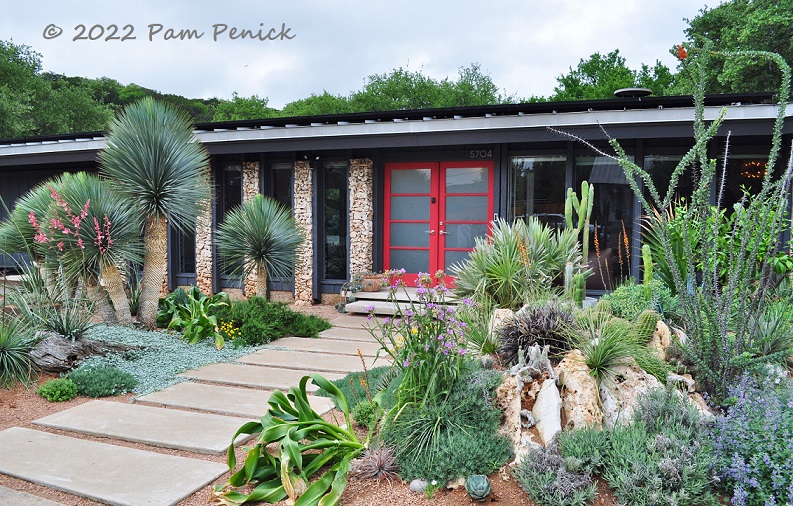
It was a pleasure to return and see many of the plants in bloom, including native red yucca (left of the path) and spiderwort (on the right).
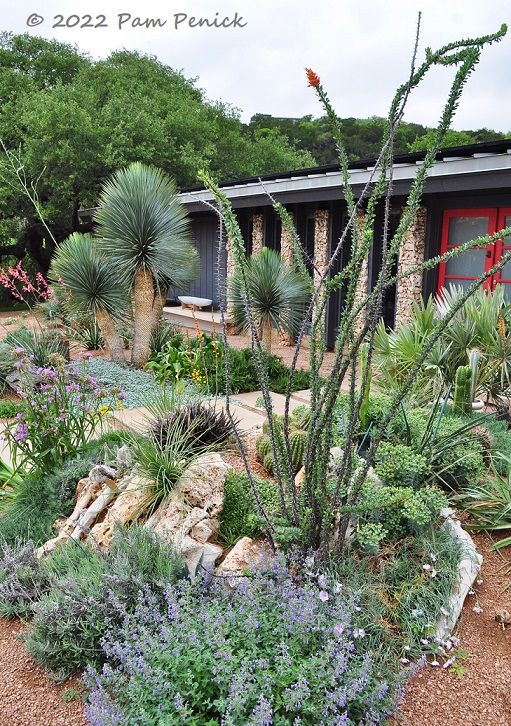
An ocotillo not only had leaves (ocotillo is often bare-stemmed) but was flowering! Native to the high desert of West Texas, ocotillo appears in Central Texas rock gardens from time to time, but it rarely seems to thrive in our humid subtropical climate. It was a treat to see this one looking so happy.
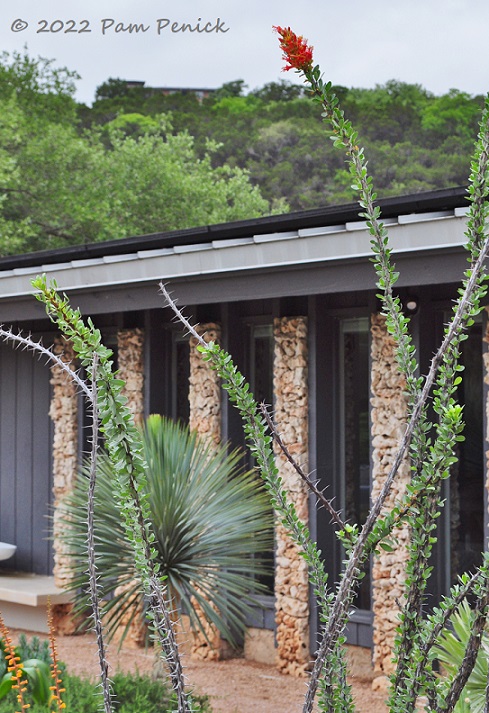
Red flower clusters appear on the tips of its upright stems.
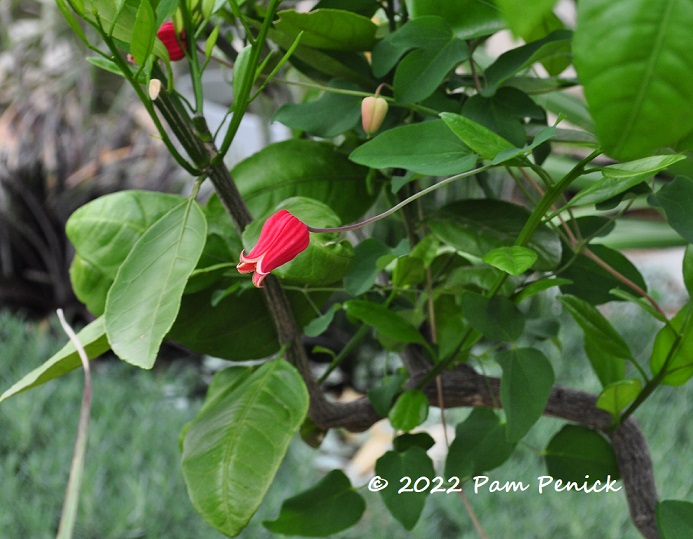
Rambling through a citrus tree, scarlet clematis echoed the ocotillo’s red flowers.
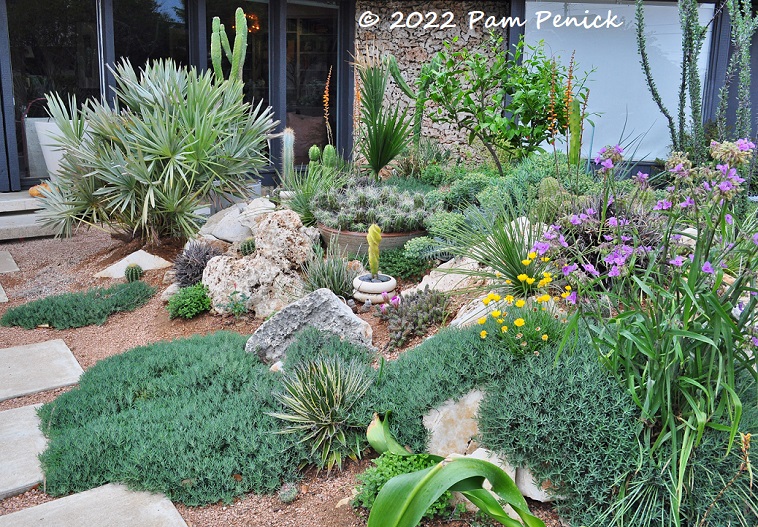
Let’s pull back for a wider view of the crevice garden along the front walk. Potted cacti — some hardy and some tender — bristle amid blue saw palmetto (Serenoa repens), small agaves, creeping groundcovers, and flowering four-nerve daisy (yellow), spiderwort (purple), and dyckia (orange spikes).
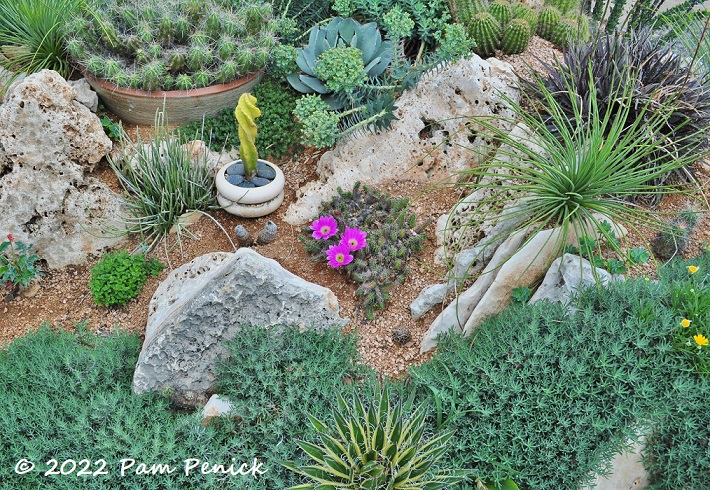
The plants and rocks are beautifully composed.
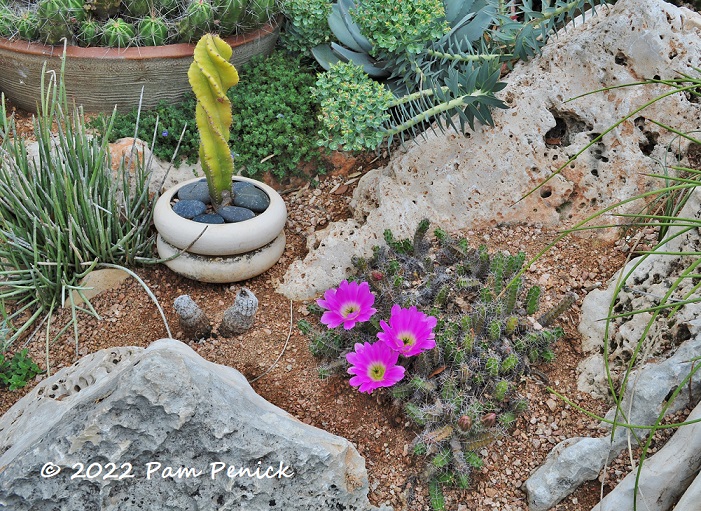
Spiral cactus (Cereus peruvianus ‘Spiralis’) in a pot and extravagantly pink, oversized flowers on a petite, spiny cactus make for a fun combo. Whenever a cactus flowers it’s a celebratory moment, one I’m enjoying in my own garden right now.
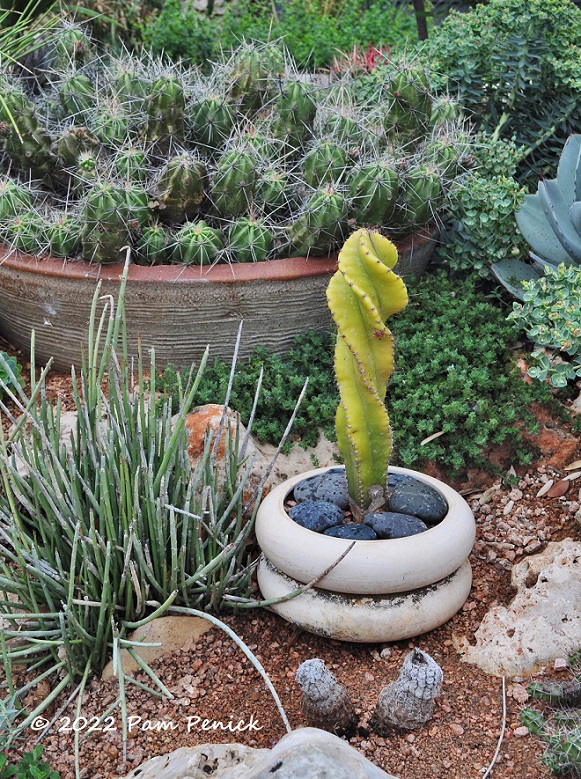
Spiral cactus
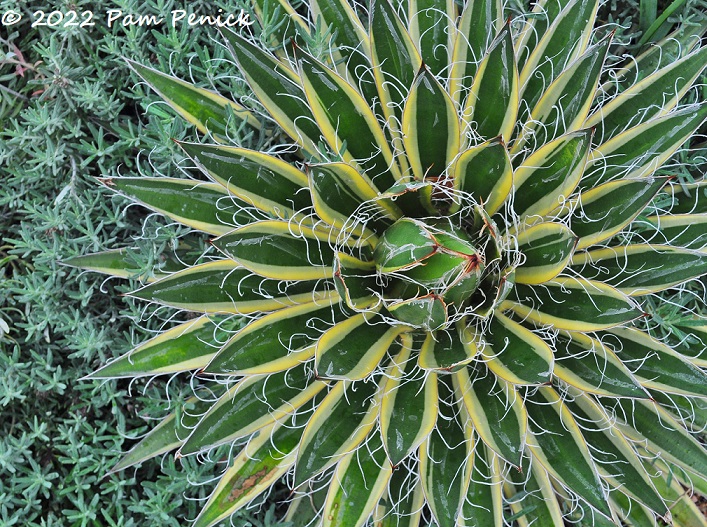
‘Quadricolor’ agave Update from commenter HB: “I think the agave is not a ‘Quadricolor’, but perhaps something like A. filifera or Agave schidigera ‘Shira ito no Ohi’, because of the threads.” I agree, and it looks like the latter to me.
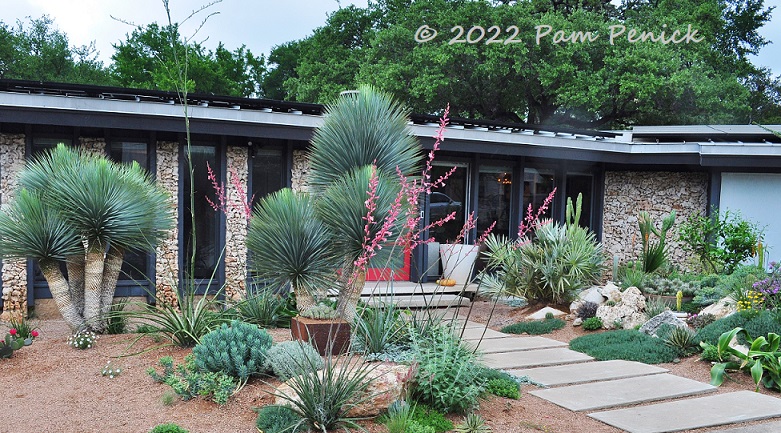
To the left of the front walk, bristle-headed Yucca rostrata are tipped with fresh, green growth. Hesperaloes flower among them, including red yucca up front and giant hesperaloe between the yuccas.
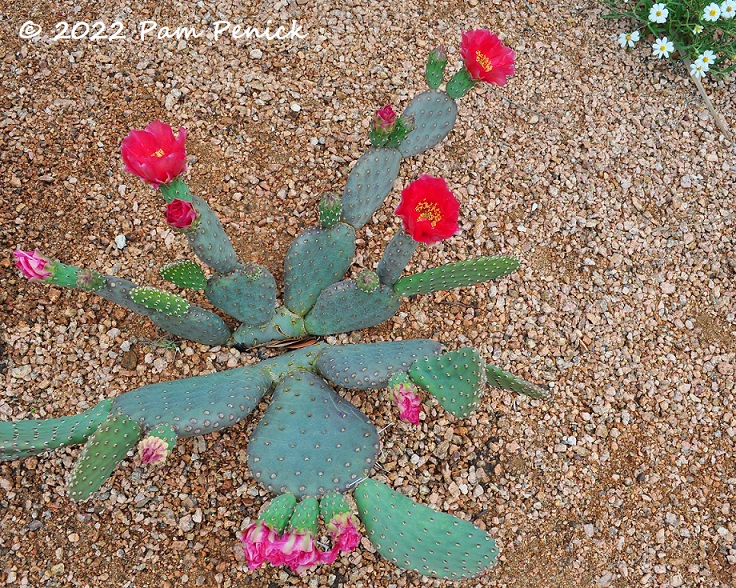
I think I’d be a prickly pear collector if I lived in a drier climate. I find them so appealing in form and flower. Coleson has one with stunning red flowers and chunky, blue-green pads. Gorgeous!
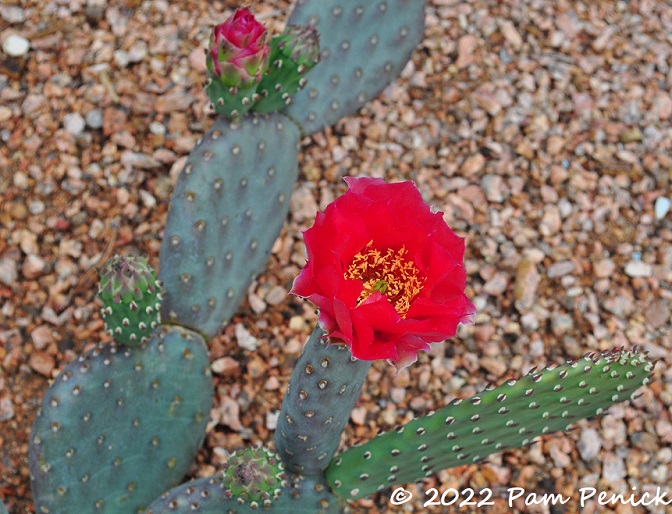
A closer look
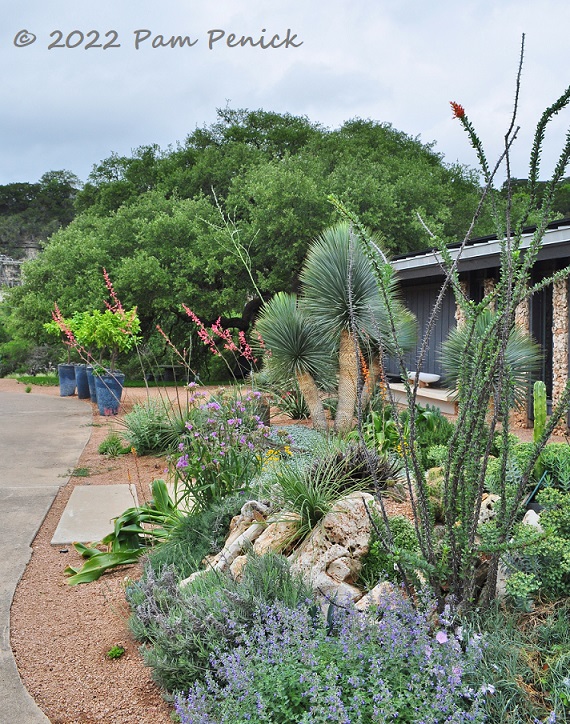
A side view of the crevice garden, with catmint and ocotillo in the foreground, spiderwort and red yucca in the middle, and citrus trees in blue pots at the back.
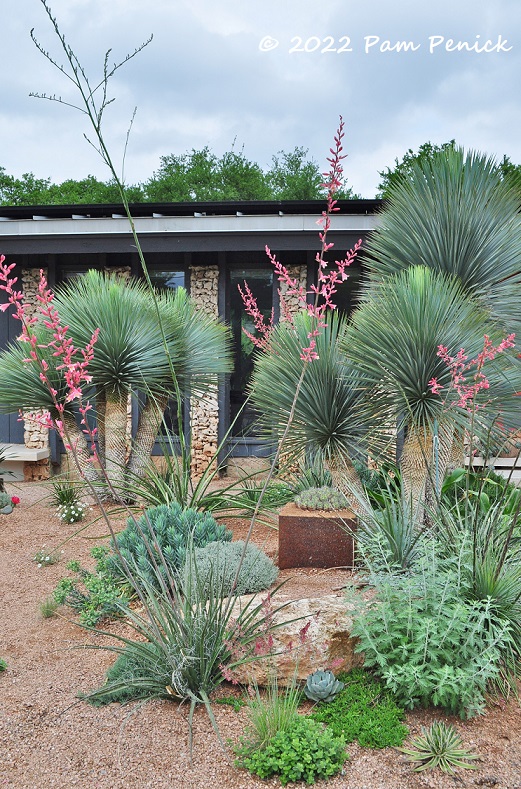
Hummingbirds must be going wild for these hesperaloe flowers. Update 5/4: John Ignacio, who helped Coleson create this garden, shared the following about the hesperaloes:
“Those are Hesperaloe campanulata I raised from seed from my specimen. It’s a Mexican species with the most open flowers in the genus that puts on much taller and more branched and floriferous spikes than our native parviflora. They’re one of the rarest species in the genus and worthy of much broader distribution.”
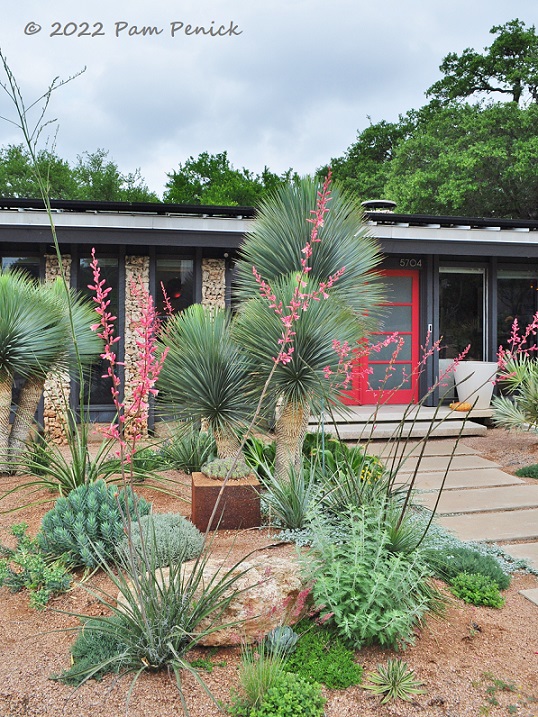
They make a coral-pink scrim as you approach the front door. The beaked yuccas screen floor-to-ceiling windows and provide some privacy from the street.
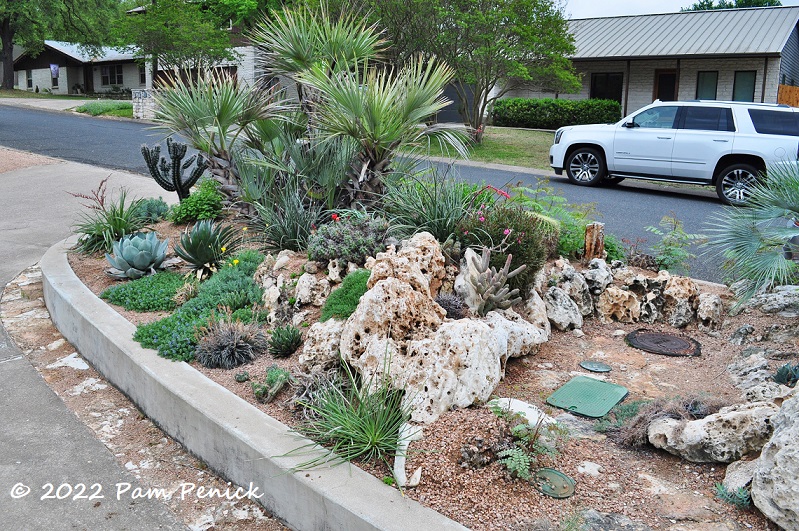
A larger crevice garden fills an island bed along the street, and also buffers passing cars. Holey limestone boulders lie on the diagonal, their gravelly crevices displaying cactus, dyckia, agave, and other dry-loving plants. Coleson left open space in the middle of the bed for access to the water meter and irrigation box.
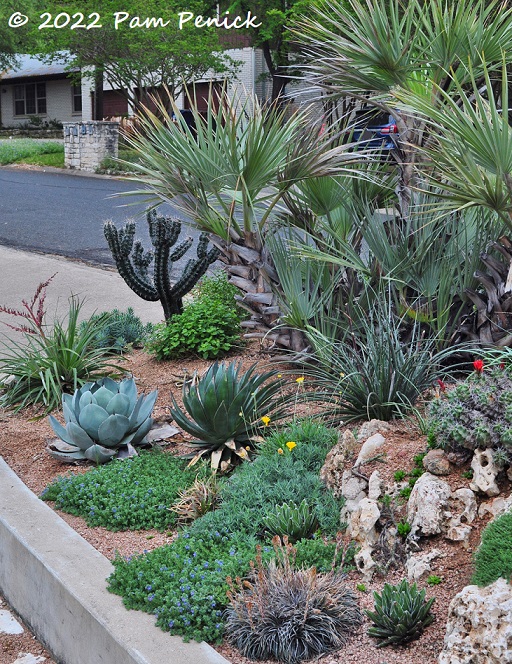
A palm nearly recovered from Snowpocalypse adds height and screening. It plays backdrop to an assortment of small agaves, dyckia, and hesperaloe, as well as some groundcovering perennials.
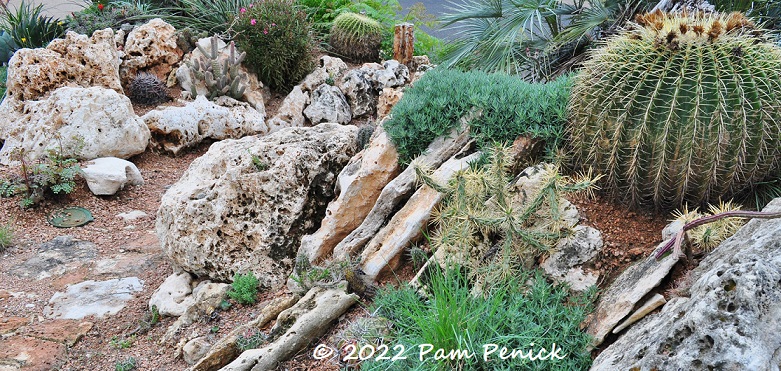
On the right, a gigantic golden barrel cactus sits regally in a high niche.
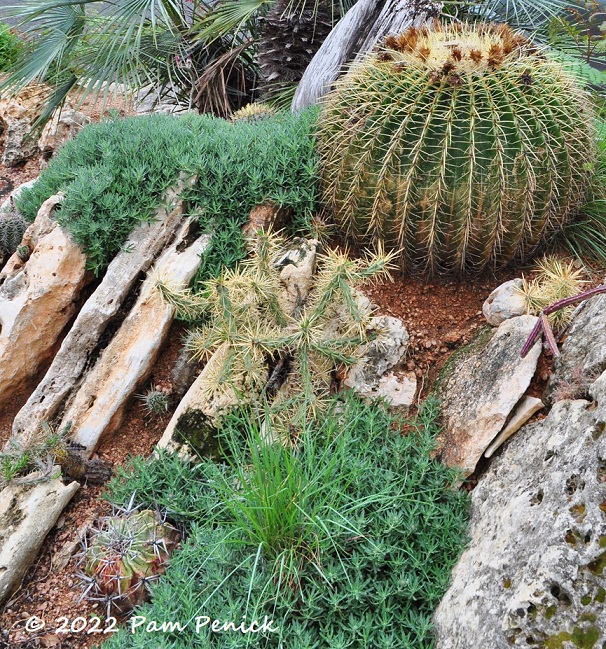
Cholla and small succulents and grasses cluster around.
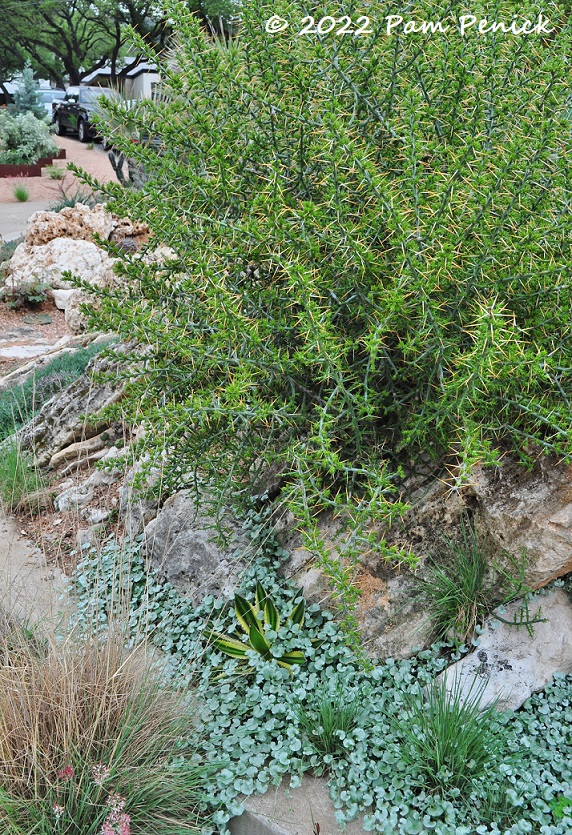
Christmas cholla (Cylindropuntia leptocaulis), a large, orange-spined shrub, is underplanted with a stream of silver ponyfoot and ‘Quadricolor’ agave.
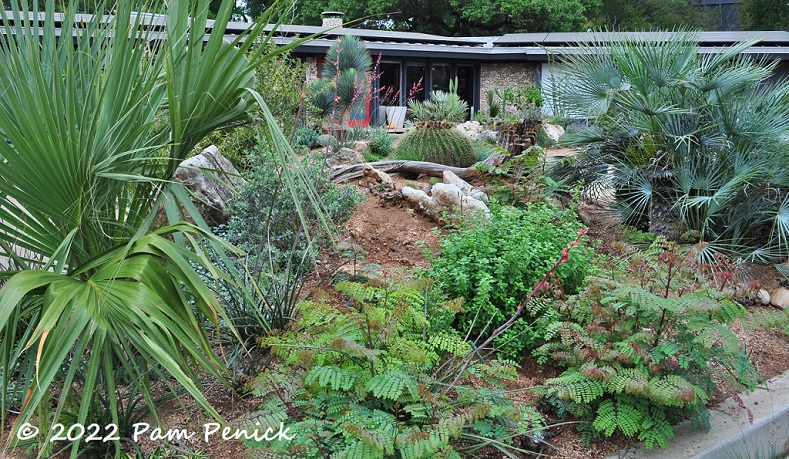
The streetside view reveals Pride of Barbados growing alongside the palms to provide more screening by summer.
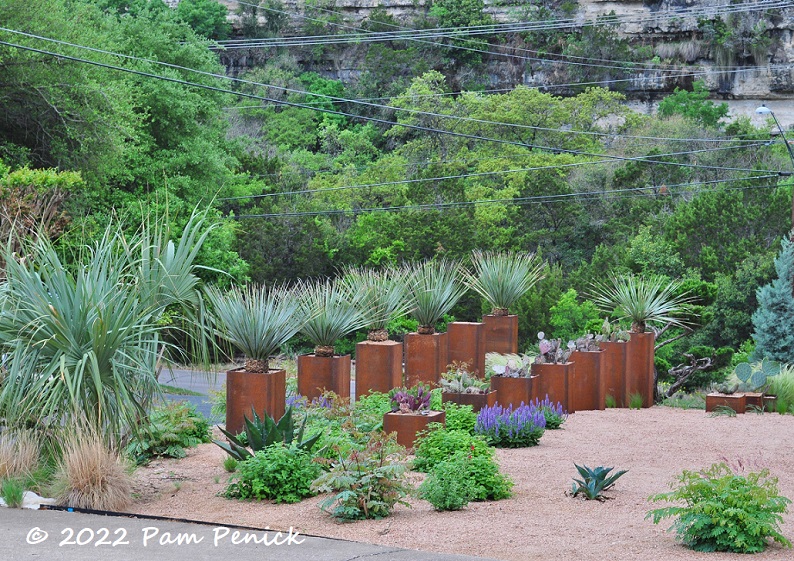
On the downhill side of the garden, a double row of square steel planters makes an eye-catching scene. They screen the busy throughway below while making clear that a gardener lives here.
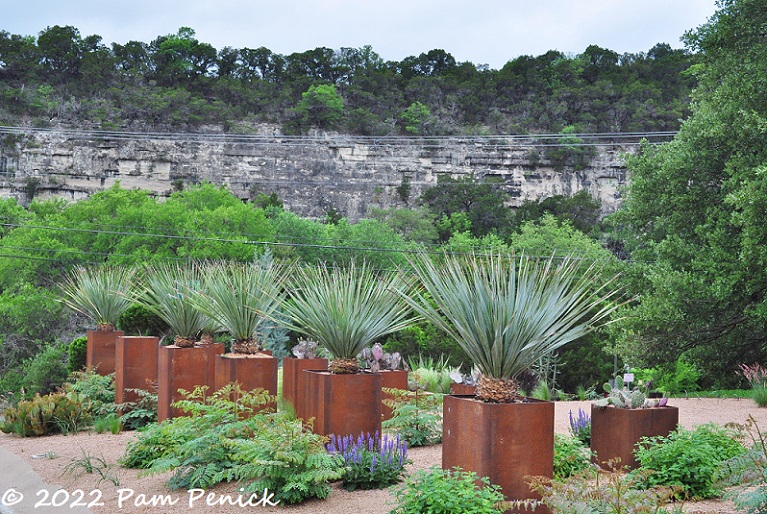
Coleson said he located a long square pipe in Houston (if I recall correctly) and had it cut to his measurements to create planters that remain at the same level as they march downhill. Pruned-up blue-green sotols seem to explode from the containers.
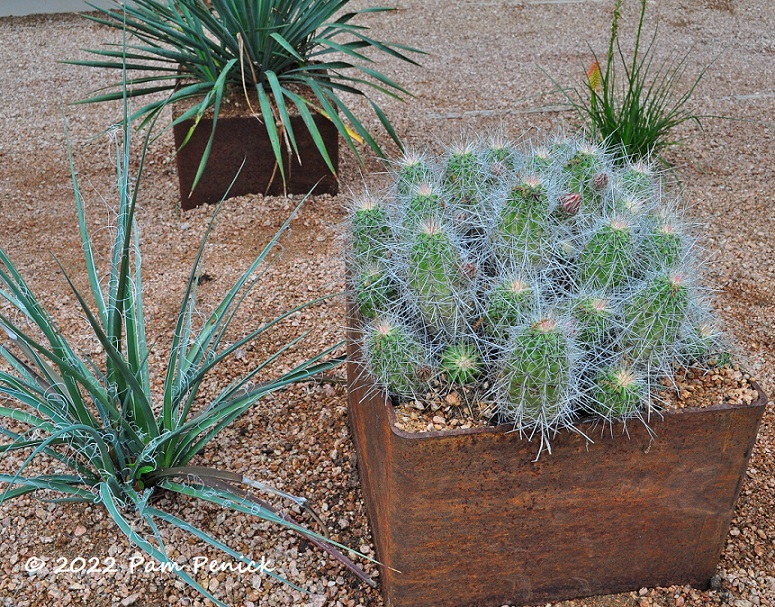
A few smaller pipe remnants display yucca and more cactus.
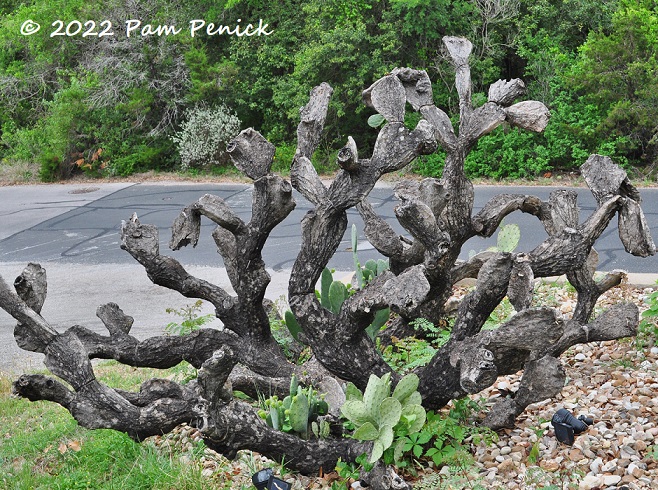
At the corner, a sculptural but freeze-dried prickly pear still stands — a relic of pre-Snowpocalypse. But notice that new pads are appearing not only at the base but along some of the seemingly dead branches. It lives!
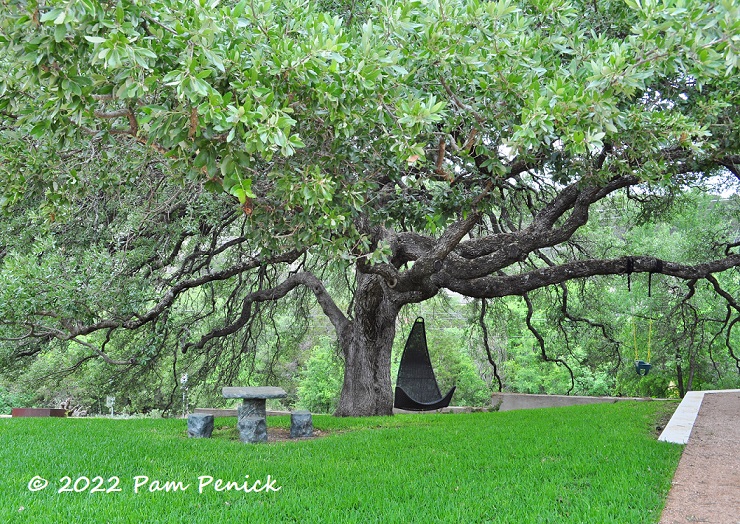
Coleson inherited some grand old live oaks that also deserve admiration. This one spreads its black limbs across half of the front yard, creating shade for a bit of lawn. A hanging chair, baby swing, and stone table and stools provide places to relax under that leafy canopy.
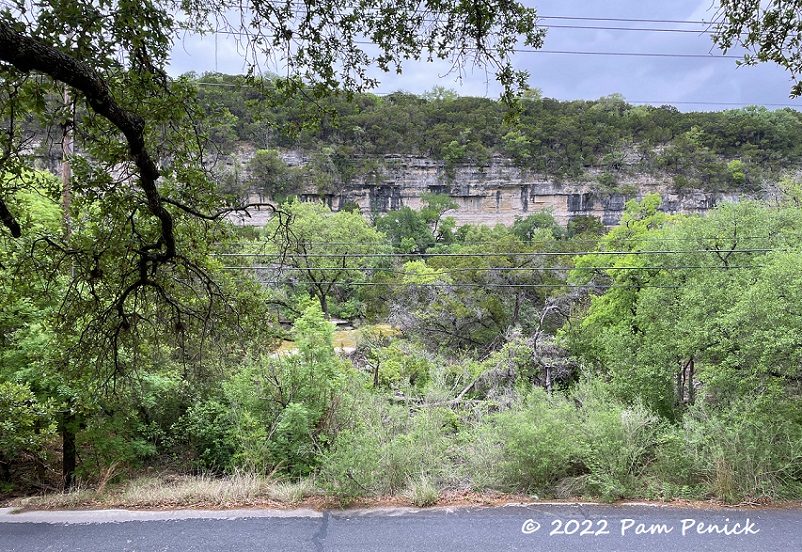
The shallow back yard wraps around the house, and part of it overlooks the limestone cliff along Bull Creek. Capital of Texas Highway (aka Loop 360) runs behind the bluff, which effectively buffers all that road noise.
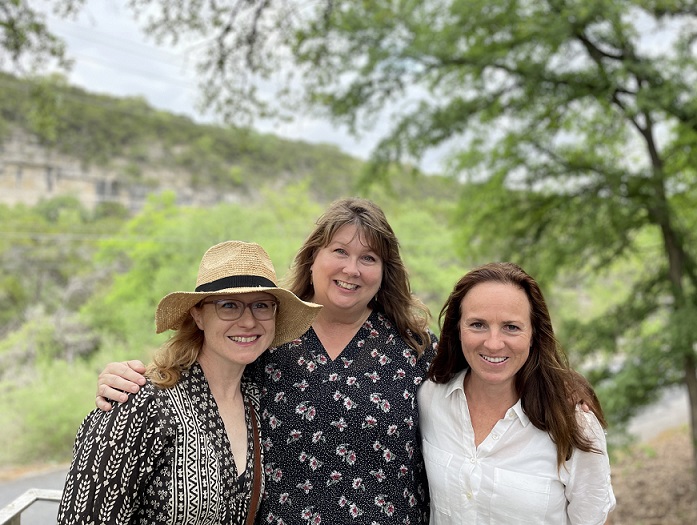
Coleson graciously let me invite along a few friends, including Lori Daul of The Gardener of Good and Evil, pictured at left. Next to me on the right is internationally known garden photographer Claire Takacs. Lori and I were both a little starstruck to meet her. Claire, an Australian who travels around the world on assignment, was in Austin to photograph gardens for a book she’s working on. Not only was I thrilled to meet her, I was happy to be able to introduce her to some gardeners and designers working creatively within the constraints of our climate to produce beautiful gardens, Coleson very much one of them.
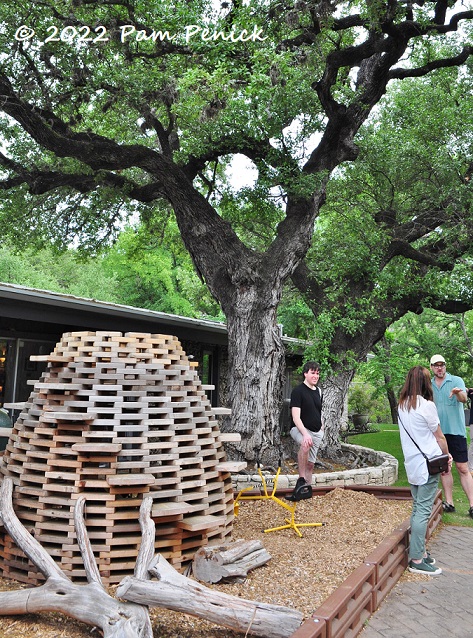
Accompanying Claire was Giacomo Guzzon (in the black shirt), an Italian landscape architect living in London. Giacomo is writing the book for which Claire is currently photographing. It was a pleasure to meet both of them, and I’m so encouraged to see writers and photographers branching out from the well-covered East Coast and West Coast corridors to explore gardens in the overlooked but vast middle of the U.S. I dream of the day when I can routinely pick up a garden book and find photos of at least a few gardens I can relate to in terms of climate and plants.
OK, getting off that soapbox, I want to point out the beehive-shaped structure above. It’s a playhouse that Coleson constructed himself from pieces of wood he meticulously measured and cut. Cantilevered steps allow climbing, or children can go inside via a doorway on the other side.
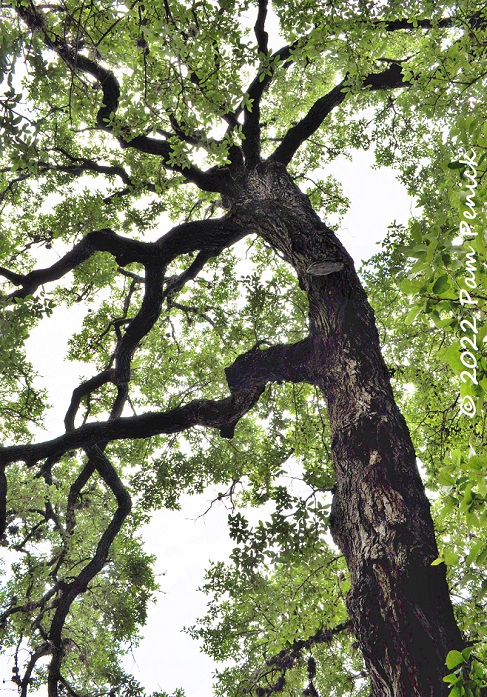
Another massive, contorted live oak creates shade here, and living sculpture.
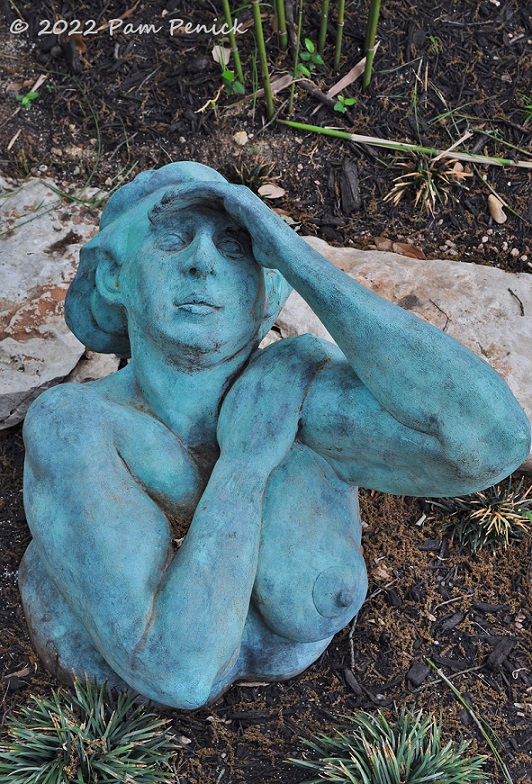
The sculpted bust of a woman, placed on the ground nearby, seems to gaze up at the tree while shading her eyes.
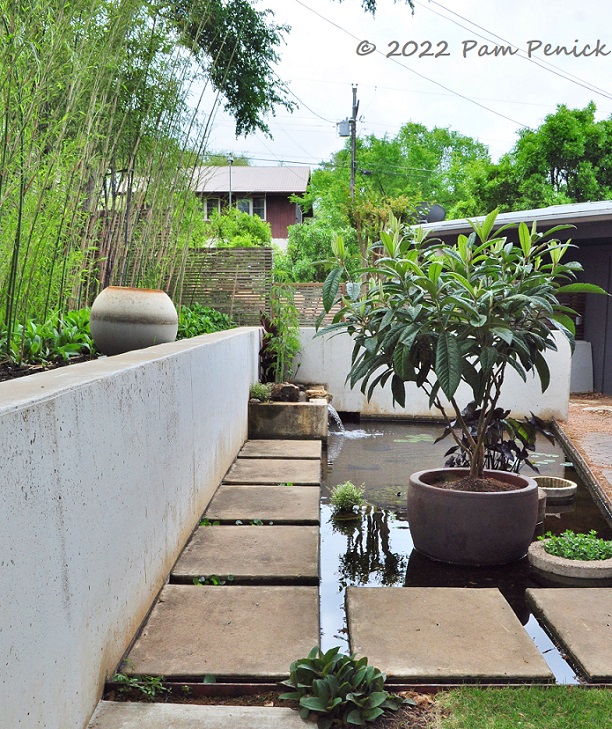
A retaining wall carves out a niche for a contemporary-style pond. Floating pavers make an L-shaped path around it, skirting a potted loquat.
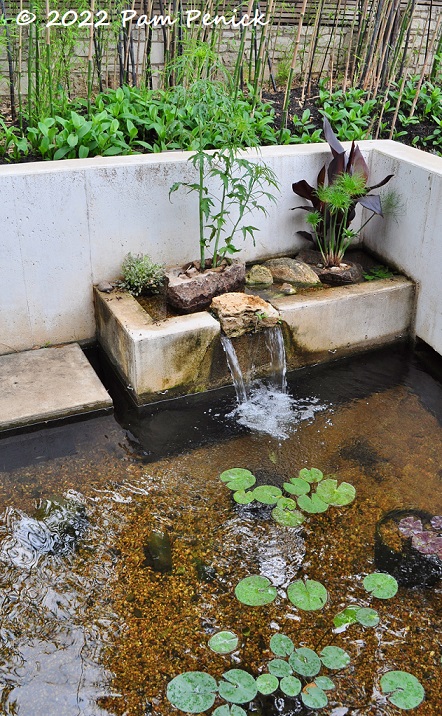
In the corner, a trough fountain is both a boggy planter and the source of a waterfall spilling into the pond.
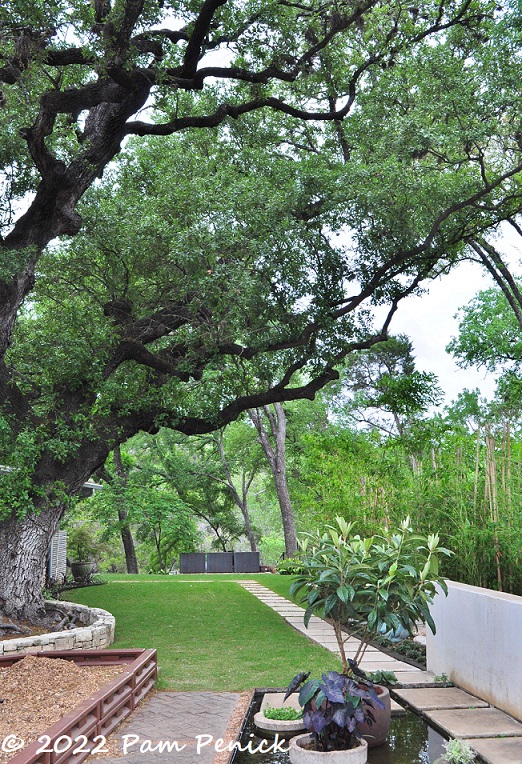
Looking back you see a shady lawn, the massive live oak, and a simple paver path extending from the floating pavers in the pond.
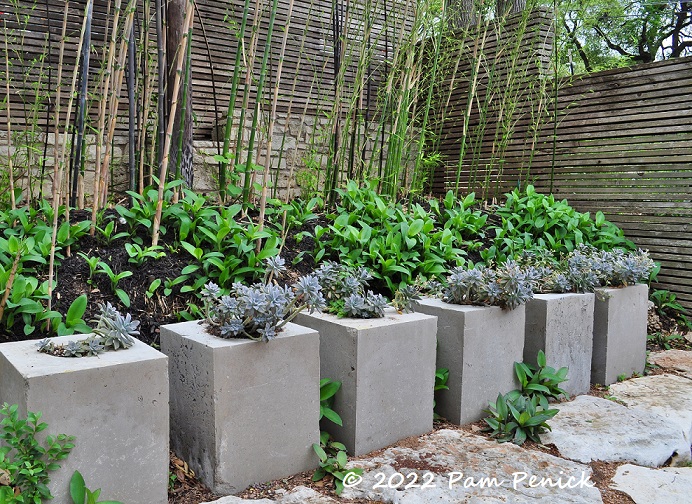
Square planters of gray Lueders limestone display gray ghost plant near the back gate.
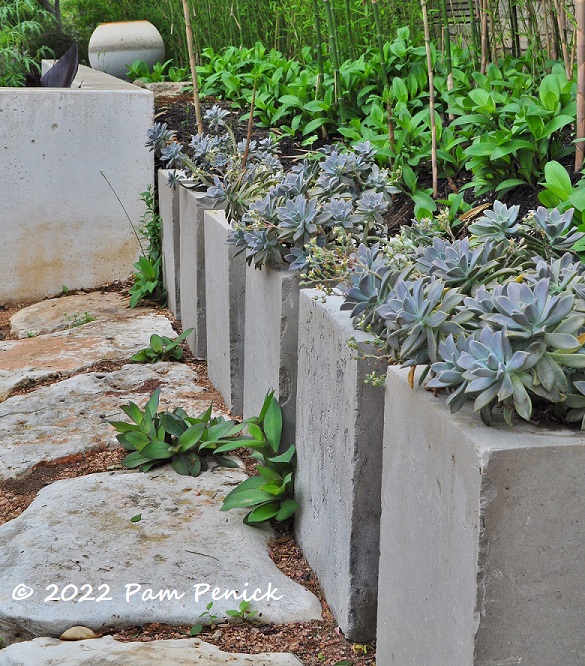
The ghost plant was flowering too, its ivory sprigs a subtle but lovely finish to the spring garden visit.
To see Coleson’s garden in late October, plus learn how he teamed up with a neighbor during Covid quarantine to build the garden, read my earlier post: A Texas-style crevice garden – and neighborly collaboration – brings midcentury Austin home to vibrant life.
__________________________
Digging Deeper
Come learn about gardening and design at Garden Spark! I organize in-person talks by inspiring designers, landscape architects, authors, and gardeners a few times a year in Austin. These are limited-attendance events that sell out quickly, so join the Garden Spark email list to be notified in advance; simply click this link and ask to be added. Season 8 kicks off in fall 2024. Stay tuned for more info!
All material © 2025 by Pam Penick for Digging. Unauthorized reproduction prohibited.


A very interesting garden. Those steel and limestone square planters immediately catch the eye! I love to see these types of ‘dry’ gardens, especially since they are far and few between here in Houston. There is such a variety of texture. And, yes, I agree about the general garden books!
The planters are such a great way to elevate dry-loving plants and show them off, and to create rhythm in the garden. And screening where needed!
Just knocks my socks off when you post on this garden. Amazing that it is so new, which just shows what intelligence, laser focus and skill were behind its construction. I think introducing Claire to this garden may just bring about your dream to see more Austin gardens in print media!
Fingers crossed, Denise! Coleson is showing one way to adapt to a drier, hotter climate without sacrificing beauty.
I’m pleased to have another opportunity to see this great garden. I’m always surprised to see how early Hesperaloe blooms in your climate – and that anyone can grow catmint in a home garden setting. (Every Nepeta I’ve ever planted has been instantaneously eaten to the ground by one or more neighborhood cats.) I love the new beehive structure.
Do you grow hesperaloe in L.A., Kris? I would think it would do well for you. Dang those cats converging on your catmint though! What a picture that makes in my mind. 🙂
WOW!
I love South Carolina, but your photos make me want to move.
I do sometimes feel like an ambassador for Austin – hah! Glad you enjoyed the post. 🙂
Those are Hesperaloe campanulata I raised from seed from my specimen. It’s a Mexican species with the most open flowers in the genus that puts on much taller and more branched and floriferous spikes than our native parviflora. They’re one of the rarest species in the genus and worthy of much broader distribution.
So glad you shared this here, John. In fact, I’m going to add this info to the post itself, for all the plant nerds reading this. It’s a beauty of a hesperaloe.
Seriously glorious! Both in design and in choice of plants. Just right.
I think the Agave is not a ‘Quadricolor’, but perhaps something like A. filifera or Agave schidigera ‘Shira ito no Ohi’, because of the threads.
Yes, I think you’re right on, HB. Looks like the latter to me. Thanks!
I remembered this garden from your previous fall visit; it is truly unforgettable. The sidewalk crevice garden is a ‘stand alone’ among crevice gardens, I simply love it. It’s not often one get to see a blooming ocotillo, that photo is a treasure.
I agree — that ocotillo in flower is a rare treat unless you’re way out west. So glad you enjoyed the post.
Beautiful presentation of a garden I would like to visit sometime. And I’m seeing the same new pads on seemingly lifeless stems on my nopal! BTW, If Claire and Giacomo are still around, send them my way so they can see and photograph my garden. And you are so right about nationally published garden books. Very little for us.
I’m glad to hear your prickly pear is coming back too, Peter. As for Claire and Giacomo, they traveled on last week.
[…] asked John if this is the Mexico native Hesperaloe campanulata that he shared with neighbor Coleson Bruce for his crevice garden. He replied that it may be, but it might also be a campanulata hybrid with our native H. […]